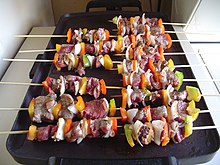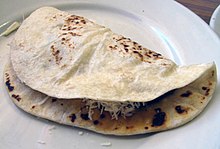Honduran cuisine
This articleneeds additional citations forverification.(November 2023) |

Honduran cuisineis a fusion ofMesoamerican,Spanish,CaribbeanandAfrican cuisines.There are also dishes from theGarifuna people.Coconutand coconut milk are featured in both sweet and savory dishes. Regional specialties includesopa de caracol,friedfish,tamales,carne asadaandbaleadas.Other popular dishes include meat roasted withchismolandcarne asada,chicken with rice and corn, and fried fish with pickled onions andjalapeños.In the coastal areas and theBay Islands,seafood and some meats are prepared in many ways, including withcoconutmilk. Among the soups theHonduransenjoy arebeansoup, mondongo soup (tripe soup), seafood soups andbeefsoups. Generally all of these soups are mixed withplantains,yuca,and cabbage, and served withcorntortillas.

Other typical dishes aremontucasor corn tamales, stuffed tortillas, and tamales wrapped in plantain leaves. Typical Honduran dishes also include an abundant selection of tropical fruits such aspapaya,pineapple,plum,sapote,passion fruit,and bananas, which are prepared in many ways while they are still green.
Common beverages for dinner or lunch includesoft drinks.Another popular drink isagua de nanceandhorchata.A popular bottled soft drink is banana-flavored Tropical Banana.
History[edit]
Precolumbian cuisine[edit]

The gastronomy of Honduras before the conquest was based on the consumption of grains such as Corn, beans, and cocoa, and crops such as pumpkins, chili peppers, Tomatoes, and several types of squash. pre-Hispanic peoples also consumed the meat of theTecolote,fish, and some mammals such as Deers as well as other products such ashoneyand various fruits such as pineapples andpapayafor the preparation of various desserts and drinks
Colonial fusion[edit]
This would be the basis of the Honduran diet that would be mixed withSpanish cuisine,which brought with it the consumption of beef,sausages,oils, andwheat.The Iberian diet in Honduras gave a total change in the eating habits of the pre-Hispanic peoples, with the introduction of dairy products being the biggest change of these, from which the diverse type of cheeses and Honduran dishes that they carry in their recipes were derived.
Modern Honduran Cuisine
Over the centuries, other ingredients have been contributed to the gastronomy of Honduras, such as African and foreign influences such as international dishes thanks to the migration of various human groups to Honduras following the liberal reform.
Breakfast[edit]

Hondurans usually have a large, hearty breakfast. It typically consists of fried eggs (whole or scrambled),refried beans,Honduran salty sour cream (crema),queso fresco,avocado, sweet fried plantains, andtortillas.It is common for most households to first prepare tortillas, a staple for nearly every dish, which are used throughout the rest of the day.
Other breakfast favorites includecarne asada(roasted meat) and Honduran spicy sausages (chorizo). A good breakfast will be accompanied with hot, dark—in this case Honduran-grown—coffee.Honduran coffee is renowned for its delicate qualities, being grown on the slopes of the Honduran mountains in rich soils of volcanic origin. A specific brand famous for its flavor comes from the Honduran region of Marcala; others are theCopáncoffee and the coffee grown inOcotepeque.[1]
Street vendors often sell breakfastbaleadasmade of flour tortillas, refried beans, andcremaorqueso fresco.Additional toppings include eggs, meat, and even pickled onions. Vendors sell smalltamalesmade of sweet yellow corn dough, calledtamalitos de elote,eaten with sour cream; freshhorchataandpozoleis also common.
Another food that can be eaten for breakfast as a dessert isrosquillas.Rosquillas can be considered as a Honduran doughnut and are made from corn (masa, cheese and yeast).
Sopa de caracol[edit]

Sopa de caracol(conchsoup) is one of the most representative dishes of the Honduran cuisine. This soup was made famous throughout Latin America because of a catchy song from Banda Blanca called "Sopa de Caracol." The conch is cooked in coconut milk and the conch's broth, with spices, yuca (cassava), cilantro, and greenbananasknown asguineo verde.Other varieties including crab, fish or shrimp are known assopa marinera.
Sopa de frijoles[edit]
This traditional soup is made by boiling black or red beans with garlic in water until soft. Once they are soft, the beans are blended, and added to a pot filled with water and with pork bones to serve as the base of the soup. Once the soup base has taken a chocolate color and has boiled enough, the bones are removed, and water is added to the pot, along with the rest of the ingredients, which may include yuca, green plantains, eggs, and many other ingredients. The soup is served with rice and tortillas, and may be accompanied with sour cream, smoked dry cheese, avocados and lemons.
Carneada[edit]
Carneada is considered one ofHonduras' national dishes, known asplato típicowhen served in Honduran restaurants. While it is a type of dish, acarneadaorcarne asada,like itsMexicancounterpart, is usually more of a social event with drinks and music centered on a feast of barbecued meat. The cuts of beef are usually marinated in sour orange juice, salt, pepper and spices, and then grilled.
The meat is usually accompanied bychimolsalsa (made of chopped tomatoes, onion and cilantro with lemon and spices), roasted plátanos (sweet plantains), spicy chorizos, olanchano cheese, tortillas, and refried mashed beans.
Rice and beans[edit]

Rice and beansis a popular side dish in the Honduran Caribbean coast. It is often calledcasamientoas in El Salvador. The most common beans used in Honduras are red beans (frijoles cheles). Typically in Honduras beans are refried and served with green fried bananas (tajadas).
Fried Yojoa fish[edit]

Fried Yojoa fish often has a more savory flavor compared to other types of fish served in the region. Yojoa fish is salted, spiced, and later deep-fried. It is frequently served with pickled red cabbage, pickled onions, and deep-fried sliced plantains (tajaditas).
Baleada[edit]

Thebaleadais one of the most common street foods in Honduras. The basic style is a flour tortilla, folded and filled with refried beans andqueso frescoor sour cream (crema). Roasted meat, avocado, plantains or scrambled eggs may be added. Honduran fast-food chains serve different kinds ofbaleadas.
Corn tortillas[edit]
Corn, ormaíz,is a staple in Honduran cuisine. Eating corn comes to Hondurans as an inheritance from the Maya-Lenca people; the Maya believed corn to be sacred, and that the father gods created men from it.
Some tortilla-based dishes includetacos fritos,in which tortillas are filled in with ground meat or chicken and rolled into a flute. The rolled tacos are then deep-fried and served with raw cabbage, hot tomato sauce, cheese and sour cream as toppings.
Catrachitasare a common simple snack, made of deep-fried tortilla chips covered with mashed refried beans, cheese. A variant of this snack arechilindrinas,deep-fried tortilla strips with hot tomato sauce and cheese. It is common in Honduran restaurants to serve ananafre,a clay pot with melting cheese or sour cream, mashed beans and sometimes choppedchorizoheated on top of a clay container with burning charcoal, with fried tortilla chips for dipping.
Enchiladas:the whole tortilla is deep fried and served with a variety of toppings. First ground pork meat is placed, next raw chopped cabbage or lettuce, then hot tomato sauce, and a slice of boiled egg.
Tortilla con quesillo:two tortillas with quesillo (a lightly salted cheese that can easily melt), in between and then pan fried; served with a tomato sauce. Mashed beans are sometimes also added as a filling with the cheese. Chismol is sometimes on top.
Condiments[edit]
Encurtidois used as an appetizer, side dish and condiment, and is a common dish in Honduran cuisine.[2]
Tegucigalpan cuisine[edit]
This refers to the cuisine and restaurants of the city ofTegucigalpa,Honduras.Rice, beans, and tortillas are a staple of the Honduran diet, and some would argue there is little difference in quality between the streetside vendors and top restaurants.[3]
The city, like in most other places in Honduras, offers a wide variety of cuisines from not only Honduras but alsoAsia,India,theMiddle East,and other regions. Tegucigalpa offers everything from street food to gourmet food in five-star restaurants.[4][5]However, according toFrommer's,"Tegucigalpa's dining scene is considerably more varied when compared to the rest of the country, but lacks the quality and depth of other Latin American cities."[3]
See also[edit]
References[edit]
- ^Ken Albala (2011).Food Cultures of the World Encyclopedia [4 volumes]: [4 volumes].Bloomsbury Publishing USA.ISBN9780313376276.
- ^"Acompaña tus comidas con un delicioso encurtido casero de cebolla roja".Diario El Heraldo(in Spanish). October 5, 2021.RetrievedOctober 24,2021.
- ^abGill, Nicholas (19 October 2009).Frommer's Honduras.Frommer's. p. 81.ISBN978-0-470-15943-9.Retrieved3 June2011.
- ^Carolyn McCarthy; Greg Benchwick; Joshua Samuel Brown (1 November 2010).Central America.Lonely Planet. pp.348–.ISBN978-1-74179-147-1.Retrieved4 June2011.
- ^"Honduran Food and Drink".honduras.embassyhomepage.Retrieved3 June2011.
External links[edit]
 Media related toCuisine of Hondurasat Wikimedia Commons
Media related toCuisine of Hondurasat Wikimedia Commons

